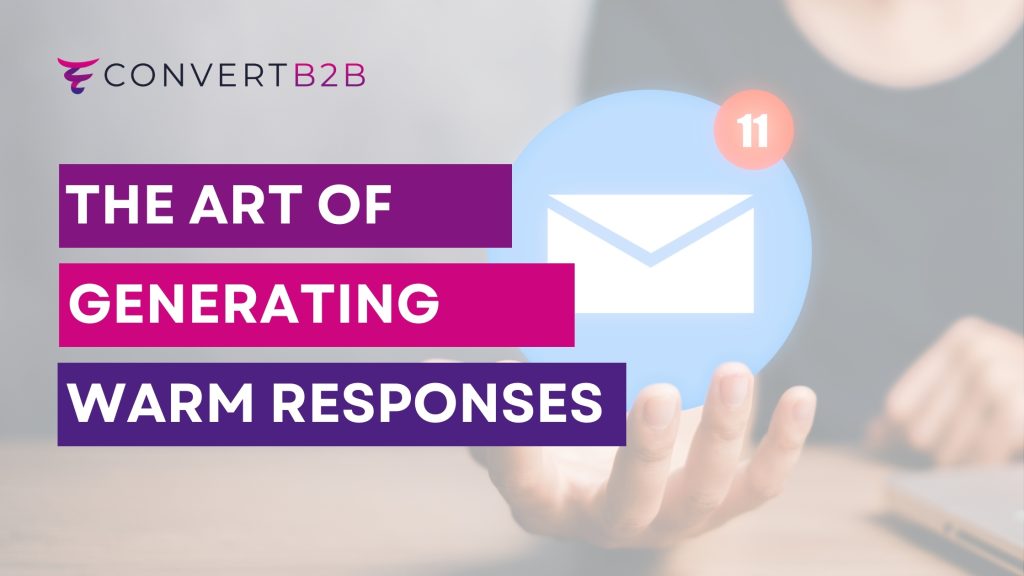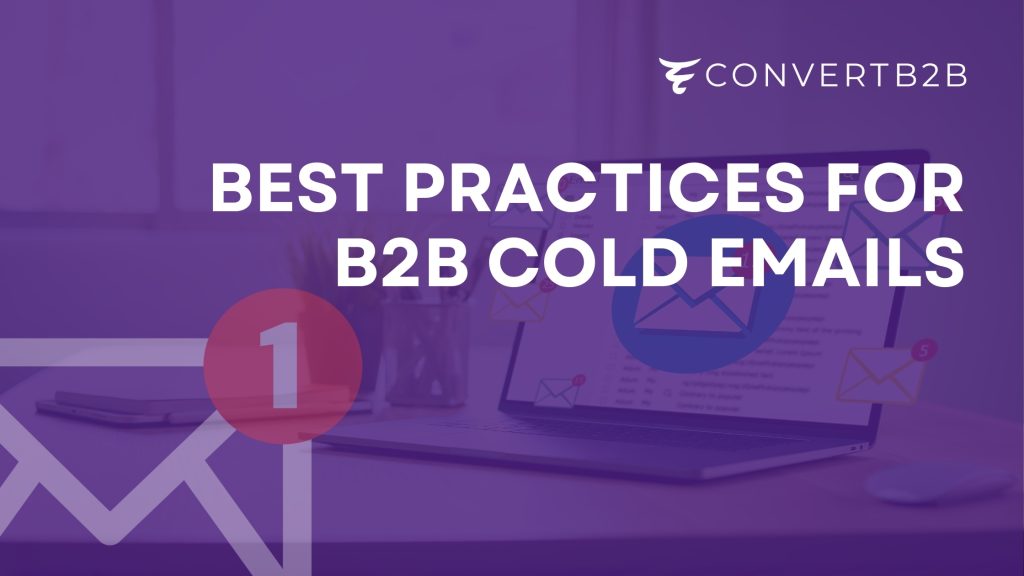Blog
How to Extract a Warm Response with a Cold Email?

If you spend one dollar on sending a cold email, you will earn 36 back. Yes, that’s the Return on Investment (ROI) of outbound email outreach. Email is one of the first gifts the internet gave us, and to this day, it is the most powerful and effective way to reach out to anyone on the grid.
Given the number of emails exchanged daily, which runs into billions (3 billion to be exact), a scientific genre has evolved to perfect the art of landing an email in the Inbox. But from the B2B marketing standpoint, a successful email campaign is still the work of dreams.
That being said, this article is about the human aspect of cold email. The art of language that manages to capture the receivers’ attention in a wink and makes them open, read and respond to a cold email. This, of course, is easier said than done.
Top 10 Cold Email Best Practices for B2B Audiences
Forget generic greetings and self-serving boasts. Below are cold email best practices and strategies that establish trust, pique curiosity, and ultimately, elicit a warm response. Make sure you’re ready to ditch the impersonal templates and embrace the power of genuine connection.

1. Keep the Subject Line Short
Long subject lines give rise to suspicions that a machine is behind pressing the sent button. Think about it. If there is no personal touch in the email, people usually don’t open it. The shorter the subject line, at least visually, it looks like a brief message from a friend who respects the receiver’s time and keeps it to the point.
2. The Greeting Should Not Be Dramatic
Try not to sound over-caring. That’s a put-off. You are a stranger, so act like one. Lines like ‘Hope you are doing great, ‘take good care of yourself, or ‘hope you are safe’ not only eat away at the crucial word count. But they sound fake.
3. Stop Boasting About Yourself
There’s a reason why this article on Forbes highlights the “We-We Syndrome” as a top B2B digital marketing blunder. The receiver is not interested in your life or work. The best bet is to start with something they find interesting – something from their business or work. If you waste the first two sentences bragging about your contribution to the world, chances are you will be relegated to the spam folder.
4. Admit That You Have Not Spoken Directly
In the first two sentences, establish that it’s an unsolicited approach. This way, you gain the receiver’s trust and show that you are honest about your approach. A mere two to three words can help you establish a connection because the receiver would lower their guard and care to read the whole email and can also click the CTA option you included.
5. Be Specific with Facts and Numbers
If you try to break the ice with a crucial data point or metric that you think will get the receivers’ attention, make sure you put in the details and they are correct. For instance, you think the receiver will respond to a news item about a competitor’s achievement. State the name of the business and from where you extracted the information.
6. Linear Thought Process
Don’t try to shove in too many ideas in a cold email. Learn how to follow a linear thought process. The email should establish the context and what action you expect the receiver to take from start to finish. Anything that veers off this course can lead to confusion, which usually means the most dreaded response: silence.
7. Don’t Ask for Time in the First Email
SDRs continue to make this recurring blunder with the hope of shortening the email cycle from cold to discovery calls. But research shows they don’t work. Because it does not make sense, it’s that simple. Asking for the receivers’ precious time on the first cold email is like walking down the street, approaching a stranger, and asking for a date. It’s creepy, to say the least. Avoid doing that.
8. Don’t Put More Than Two Hyperlinks
Though technically, it is recommended that your cold emails should not have more than two links or the chances of deliverability fall to almost half. But even from the perspective of email composition that works, more than two hyperlinks look too spammy because it looks too pitchy. Keep the CTA hyperlinked (if needed) that’s all.
9. Avoid Doubt Words
In the business of sales, the most important asset one can build is authority. A golden rule for salespeople: Sound definite. Your language should sound like you know what you’re talking about. It should exude confidence and lends authenticity to your
Voice. Words like ‘maybe,’ ‘if,’ and ‘possibly’ put the reader on the back foot and make them rethink your claims in the email.
10. CTA Should Be About Interest or Learning More
The call to action should be effortless. It should be put at the end of the email, and the reader should get it instantly without thinking about it. If you wrote a brilliant email that manages to cast its spell, a CTA that’s not clear can put off a receiver in a second and change their mind. A simple click should lead to further information that can help them make an informed decision on time. Nothing more.
The Expert Opinion: Tips on Generating Guaranteed Warm Responses
We reached out to several industry experts to get their opinions, and let’s just say, the B2B professionals of our industry did not disappoint. Apart from the best practices discussed above, below are some key insights that are bound to prove useful when it comes to increasing your chances of getting warm responses. Let’s hear it from the experts themselves.
Personalization is Key
The more personalized an email, the better its chances of getting the desired result. But that’s easier said than done. We reached out to Magee Clegg, the CEO of Cleartail Marketing, and he emphasized the importance of leveraging detailed insights about the target company.
Magee mentions, “Rather than just introducing our services, we’ve found success in sharing a piece of proprietary data analysis or an insight relevant to the recipient’s industry, showing immediate value without any strings attached.”
Here are some suggestions based on Magee’s experience:
- Highlight specific challenges or recent achievements mentioned in press releases or social media to make your email feel more informed and tailored to the recipient’s current situation.
- Offer high-value content within the cold email itself. Share a piece of proprietary data analysis or an insight relevant to the recipient’s industry, showing immediate value.
- Position the email as a starting point for a conversation rather than a hard sell. Conclude your emails with an open-ended question related to a challenge or trend in their industry, inviting them to share their views.
Focus on Intent Signals
When we got in touch with Mark Colgan from Yellowo.co.uk, he stressed the importance of sending relevant messages. Mark recommends using signals and intent data to target prospects who are more likely to be receptive to your message.

According to him, “Signals and intent data signify that prospects might be more likely to buy or be in-market for solutions.” Here’s an example from him:
- If someone starts a new role, they are more likely to make purchasing decisions in the first 90 days. So if you offer a solution that can help them in their new role, this would be an excellent time to send them a targeted email.
Keep it Short and to the Point
We spoke to former Google employee and entrepreneur Kevin Miller, and he emphasizes keeping your email concise. Business owners are busy, so getting straight to the point is crucial.
Kevin suggests, “Business owners are very busy, so creating an email that goes on forever is a quick way for them to lose interest.” He also recommends “not to lay everything out on the table at once,” and that “it is important to remember that the whole goal of an introductory cold email is to get them to inquire further.”
Here are Kevin’s recommendations for keeping your email short:
- Limit your email to two paragraphs.
- Touch on the main points early.
- Provide easy-to-find contact information.
- Avoid irrelevant or non-essential details.
Is There A Silver Bullet for Generating Warm Responses?
With so many automation tools that offer critical intelligence, the success of a cold email campaign still remains elusive. Sadly though, there is no silver bullet. There are best practices that you can follow and hope for the best output. Insights that come from professionals who have done it time and again are also critical since they shape your likelihood of gaining success.
That being said, try to incorporate the above discussed key elements in your email; you will see a marked difference in the response rate because they work.

